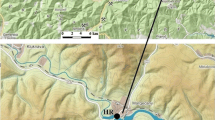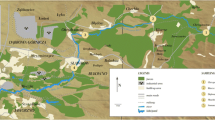Abstract
Heavy metal pollution in sediments derived from the Deûle canal and sampled at different sites not far from a smelting plant has been examined in the present work in order to identify the sources of these metals and to assess the sediment environmental quality. The total concentrations of lead, zinc, cadmium, thallium, indium and tin in the samples were determined using inductively coupled plasma-atomic emission spectroscopy (ICP-AES). Our investigations have revealed that metal pollution is readily apparent in the studied sediments, with metals contents largely exceeding those measured in the background soils: maximum values are obtained for sediments collected near the industrial zone. The chemical forms of Pb, Zn, Cd, Tl, In and Sn in these sediments have also been studied using a sequential extraction method in order to evaluate their possible mobility, bioavailability and toxicity in this aquatic environment. Overall, the averaged fractionation of Pb and Zn is dominated, in a decreasing order, by the easily reducible, oxidizable and carbonate fractions. The importance of oxidizable phase (which is assumed to be composed mainly of organic matter and sulphides) in the Pb and Zn fractionations has been confirmed by the detection of X-ray diffraction peaks ascribed to galena (PbS) and wurtzite (ZnS) in contaminated sediment samples. Anthropogenic Tl, In, and Cd are mainly retained in Fe–Mn oxides/hydroxides, whereas anthropogenic Sn predominates in aluminosilicates/clays. We suspect that elevated percentage levels of Pb, Zn, Cd and In in the reducible fraction constitute a particular potential risk to this aquatic environment in case early diagenetic phenomena (that are observed in the sedimentary material) and physical disturbances (that occur in the water column) both take place strongly in the medium.





Similar content being viewed by others
References
Agnieszka, S., & Wieslaw, Z. (2002). Application of sequential extraction and the ICP-AES method for study of the partitioning of metals in fly ashes. Microchemical Journal, 72, 9–16.
Ajay, S. O., & van-Loon, G. W. (1989). Studies on redistribution during the analytical fractionation of metals in sediments. Science of the Total Environment, 87/88, 171–187.
Baffi, F., Ianni, C., Soggia, F., & Maggi, E. (1998). Evaluation of the acetate buffer attack of a sequential extraction scheme for marine particulate metal speciation studies by scanning electron microscopy with energy dispersive X-ray analysis. Analytica Chimica Acta, 360, 27–34.
Baruah, N. K., Kotoky, P., Bhattcharyya, K. G., & Borah, G. C. (1996). Metal speciation in Jhanji River sediments. Science of the Total Environment, 193, 1–12.
Belzile, N., Lecomte, P., & Tessier, A. (1989). Testing readsorption of trace elements during partial chemical extractions of bottom sediments. Environmental Science and Technology, 23, 1015–1020.
Billon, G., Ouddane, B., & Boughriet, A. (2001a). Artefacts in the speciation of sulfides in anoxic sediments. Analyst, 126, 1805–1809.
Billon, G., Ouddane, B., Laureyns, J., & Boughriet, A. (2001b). Chemistry of metal sulfides in anoxic sediments. Physical Chemistry Chemical Physics, 3, 3586–3592.
Borovec, Z., Tolar, V., & Mraz, L. (1993). Distribution of some metals in sediments of the central part of the Labe (Elbe) River, Czech Republic. Ambio, 22, 200–205.
Bryan, G. W., & Langston, W. J. (1992). Bioavailability, accumulation and effects of heavy metals in sediments with special reference to United Kingdom estuaries – A review. Environmental Pollution, 76, 87–131.
Calmano, W., & Forstner, U. (1983). Chemical extraction of heavy metals in polluted river sediments in central Europe. Science of the Total Environment, 28, 77–90.
Campanella, L., Dorazio, D., Petronio, B. M., & Pietrantonio, E. (1995). Proposal for a metal speciation study in sediments. Analytica Chimica Acta, 309, 387–393.
Canfield, D. E., Raiswell, R., Westrich, J. T., Reaves, C. M., & Berner, R. A. (1986). The use of chromium reduction in the analysis of reduced inorganic sulfur in sediments and shales. Chemical Geology, 54, 149–155.
Comber, S. D. W., Gunn, A. M., & Whalley, C. (1995). Comparison of the partitioning of trace metals in the Humber and Mersey estuaries. Marine Pollution Bulletin, 30, 851–860.
Cornwell, J. C., & Morse, J. W. (1987). The characterization of iron sulfide minerals in anoxic marine sediments. Marine Chemistry, 22, 193–206.
Fiedler, H. D., Lopez-Sanchez, J. F., Rubio, R., Rauret, G., Quevauviller, P., & Ure, A. M. (1994). Study of the stability of extractable trace metal contents in a river sediment using sequential extraction. Analyst, 119, 1109–1114.
Flores-Rodriguez, J., Bussy, A. L., & Thévenot, D. R. (1994). Toxic metals in urban runoff: Physico-chemical mobility assessment using speciation schemes. Water Science and Technology, 29(1–2), 83–93.
Galvez-Cloutier, R., & Dubé, J. S. (1997). An evaluation of fresh water sediments contamination: The Lachine Canal sediment case, Montreal, Canada. Part II: Heavy metal particulate speciation study. Water, Air and Soil Pollution, 102, 281–302.
Gibson, M. J., & Farmer, J. G. (1986). Multi-step sequential chemical extraction of heavy metals from urban soils. Environmental Pollution Bulletin, 11, 117–135.
Gomez-Ariza, J. L., Giraldez, I., Sanchez-Rodas, D., & Moralesm, E. (2000). Metal sequential extraction procedure optimized for heavily polluted and iron oxide rich sediments. Analytica Chimica Acta, 414, 151–164.
Ho, D., & Evans, G. J. (1997). Operational speciation of cadmium, copper, lead and zinc in the NIST standard reference materials 2710 and 2711 (Montana soil) by the BCR sequential extraction procedure and flame atomic absorption spectrometry. Analytical Communications, 34, 363–364.
Ianni, C., Magi, E., Rivaro, P., & Ruggieri, N. (2000). Trace metals in Adriatic coastal sediments: Distribution and speciation pattern. Toxicology and Environmental Chemistry, 78, 73–92.
Jones, B., & Turki, A. (1997). Distribution and speciation of heavy metals in superficial sediments from the Tees estuary, north-east England. Marine Pollution Bulletin, 34(10), 768–779.
Jordao, C. P., & Hickless, G. (1989). Chemical associations of Zn, Cd, Pb and Cu in soils and sediments determined by the sequential extraction technique. Environmental Technology Letters, 10, 743–752.
Kersten, M., & Forstner, U. (1986). Chemical fraction of heavy metals in anoxic estuarine and coastal sediments. Water Science and Technology, 18, 121–130.
Klavins, M., Briede, A., Rodinov, V., Kokorite, I., Parele, E., & Klavina, I. (2000). Heavy metals in rivers of Latvia. Science of the Total Environment, 262, 175–183.
Korfali, S. I., & Davies, B. E. (2004). Speciation of metals in sediment and water in a river underlain by limestone: Role of carbonate species for purification capacity of rivers. Advances in Environmental Research, 8, 599–612.
Li, X. D., Shen, Z. G., Wai, O. W. H., & Li, Y. S. (2001). Chemical forms of Pb, Zn, and Cu in the sediment profiles of the Pearl River Estuary. Marine Pollution Bulletin, 42, 215–223.
Lopez-Sanchez, J. F., Sahukilo, A., Fiedler, H. D., Rubio, R., Rauret, G., Muntau, H., et al. (1998). CRM 601, a stable material for its extractable content of heavy metals. Analyst, 123, 1675–1677.
Martin, R., Sanchez, D. M., & Gutierrez, A. M. (1998). Sequential extraction of U, Th, Ce, La and some heavy metals in sediments from Ortigas River, Spain. Talanta, 46, 1115–1121.
Ngiam, L.-S., & Lim, P.-E. (2001). Speciation patterns of heavy metals in tropical estuarine anoxic and oxidized sediments by different sequential extraction schemes. Science of the Total Environment, 275, 253–261.
Nilsson, O., & Sternbeck, J. (1999). A mechanistic model for calcite growth using surface speciation. Geochimica et Cosmochimica Acta, 63, 217–255.
Nriagu, J. O. (1998). History, production, and uses of thallium. In J. O. Nriagu (Ed.), Thallium in the environment (pp. 7–8). New York: Wiley.
Nriagu, J. O., & Coker, R. D. (1980). Trace metals in humic and fulvic acids from lake Ontario sediments. Environmental Science and Technology, 4, 443–446.
Pardo, R. E., Perez-Barrado, L., & Vega, M. (1990). Determination and speciation of heavy metals in sediments of the Pisuerga river. Water Research, 24(3), 373–379.
Prieto, G. (1998). Geochemistry of heavy metals derived from gold-bearing sulphide minerals in the Marmato District (Colombia). Journal of Geochemical Exploration, 64, 215–222.
Quevauviller, P., Rauret, G., Lopez-Sanchez, J. F., Rubio, R., Ume, A., & Muntau, H. (1997). The certification of the EDTA-extractable contents (mass fractions) of Cd, Cr, Ni, Pb and Zn in sediment following a three-step sequential extraction procedure. CRM 601. EUR 17554 EN, European Commission/bcr information, Bruxelles.
Ramirez, M., Massolo, S., Soggia, F., & Magi, E. (2005). Metal speciation and environmental impact on sandy beaches due to El Salvador copper mine, Chile. Marine Pollution Bulletin, 50, 62–72.
Ramos, L., Hernandez, L. M., & Gonzalez, M. J. (1994). Sequential fraction of copper, lead, cadmium and zinc in soils from or near Donana National Park. Journal of Environmental Quality, 23, 50–57.
Ranu, G., Tandon, S. N., Mathur, R. P., & Singh, O. V. (1993). Speciation of metals in Yamuna river sediments. Science of the Total Environment, 136, 229–242.
Rauret, G., Lopez-Sanchez, J. F., Sahuquillo, A., Rubio, R., Davidson, C., Ure, A. (1999). Improvement of the BCR three step sequential extraction procedure prior to the certification of new sediment and soil reference materials. Journal of Environmental Monitoring, 1, 57–61.
Reeder, R. J. (1996). Interaction of divalent cobalt, zinc, cadmium, and barium with the calcite surface during layer growth. Geochimica et Cosmochimica Acta, 60, 1543–1552.
Ryssen, R. V., Leermakers, M., & Baeyens, W. (1999). The mobilization potential of trace metals in aquatic sediments as a tool for sediment quality classification. Environmental Science & Policy, 2, 75–86.
Salomons, W. (1993). Adoption of common schemes for single and sequential extractions of trace metals in soil and sediments. International Journal of Environmental Analytical Chemistry, 51, 3–4.
Schwarz-Schampera, U., & Herzig, P. M. (2002). Indium: Geology, mineralogy, and economics (p. 257). Berlin Heidelberg New York: Springer.
Sterckeman, T., Douay, F., Proix, N., & Fourrier, H. (2000). Vertical distribution of Cd, Pb and Zn in soils near smelters in the North of France. Environmental Pollution, 107, 377–389.
Sterckeman, T., Douay, F., Proix, N., Fourrier, H., & Perdrix, E. (2002). Assessment of the contamination of cultivated soils by eighteen trace elements around smelters in the North of France. Water, Air and Soil Pollution, 135, 173–194.
Tessier, A., & Campbell, P. G. C. (1988). Comment on the testing of the accuracy of an extraction procedure for determinating the partitioning of trace metals in sediments. Analytical Chemistry, 60, 1475–1476.
Tessier, A., Campbell, P. G. C., & Bisson, M. (1979). Sequential extraction procedure for the speciation of particulate trace metals. Analytical Chemistry, 51, 844–851.
Tessier, A., Campbell, P. G. C., & Bisson, M. (1980). Trace metal speciation in the Yamaska and St. François rivers (Quebec). Canadian Journal of Earth Sciences, 17, 90–105.
Tu, Q., Shan, X., & Ni, Z. (1994). Evaluation of a sequential extraction procedure for the fractionation of amorphous iron and manganese oxides and organic matter in soils. Science of the Total Environment, 151, 159–165.
Ure, A. M., Quevauviller, P., Muntau, H., & Griepink, B. (1993). Speciation of heavy metals in solids and harmonization of extraction techniques undertaken under the auspices of the BCR of the Commission of the European Communities. International Journal of Environmental Analytical Chemistry, 51, 135–151.
Usero, J., Gamero, M., Morillo, J., & Gracia, I. (1998). Comparative study of three sequential extraction procedures for metals in marine sediments. Environment International, 24, 478–496.
Yang, C., Chen, Y., Peng, P., Li, C., Chang, X., & Xie, C. (2005). Distribution of natural and anthropogenic thallium in the soils in an industrial pyrite slag disposing area. Science of the Total Environment, 341, 159–172.
Zdenek, B. (1996). Evaluation of the concentrations of trace elements in stream sediments by factor and cluster analysis and the sequential extraction procedure. Science of the Total Environment, 177, 237–250.
Author information
Authors and Affiliations
Corresponding author
Rights and permissions
About this article
Cite this article
Boughriet, A., Proix, N., Billon, G. et al. Environmental Impacts of Heavy Metal Discharges from a Smelter in Deûle-canal Sediments (Northern France): Concentration Levels and Chemical Fractionation. Water Air Soil Pollut 180, 83–95 (2007). https://doi.org/10.1007/s11270-006-9252-5
Received:
Accepted:
Published:
Issue Date:
DOI: https://doi.org/10.1007/s11270-006-9252-5




